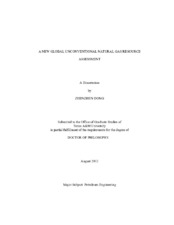| dc.description.abstract | In 1997, Rogner published a paper containing an estimate of the natural gas in place in unconventional reservoirs for 11 world regions. Rogner's work was assessing the unconventional gas resource base, and is now considered to be very conservative. Very little is known publicly about technically recoverable unconventional gas resource potential on a global scale. Driven by a new understanding of the size of gas shale resources in the United States, we estimated original gas in place (OGIP) and technically recoverable resource (TRR) in highly uncertain unconventional gas reservoirs, worldwide.
We evaluated global unconventional OGIP by (1) developing theoretical statistic relationships between conventional hydrocarbon and unconventional gas; (2) fitting these relationships to North America publically available data; and (3) applying North American theoretical statistical relationships to evaluate the volume of unconventional gas resource of the world. Estimated global unconventional OGIP ranges from 83,300 (P10) to 184,200 (P90) Tcf.
To assess global TRR from unconventional gas reservoirs, we developed a computer program that we call Unconventional Gas Resource Assessment System (UGRAS). In the program, we integrated a Monte Carlo technique with an analytical reservoir simulator to estimate the original volume of gas in place and to predict production performance. We used UGRAS to evaluate the probabilistic distribution of OGIP, TRR and recovery factor (RF) for the most productive unconventional gas formations in the North America. The P50 of recovery factor for shale gas, tight sands gas and coalbed methane is 25%, 79% and 41%, respectively.
Finally, we applied our global OGIP assessment and these distributions of recovery factor gained from our analyses of plays/formations in the United States to estimate global technically recoverable unconventional gas resource. Global technically recoverable unconventional gas resource is estimated from 43,000 (P10) to 112,000 (P90) Tcf. | en |


